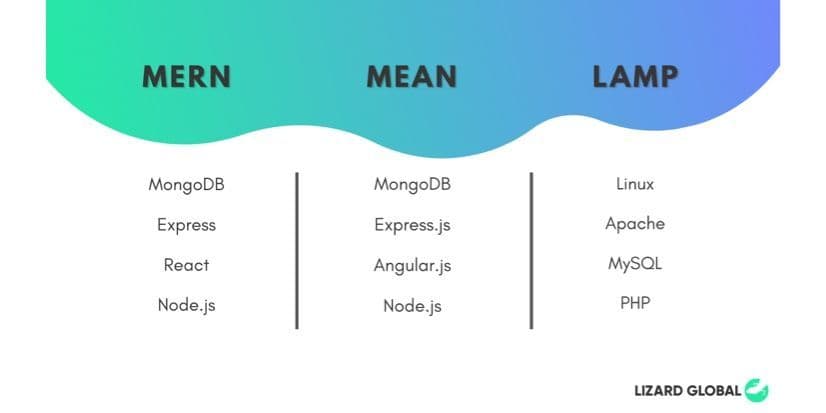software development
app development
+ 1 more ...
How To Pick The Right Tech Stack For Your Development Project?
21 Dec 2020
by Lotte, Digital Content Specialist
21 Dec 2020
by Lotte, Digital Content Specialist
software development
app development
technology stack
How To Pick The Right Tech Stack For Your Development Project?
Table of contents
Contact us
We will get back to you in the next 48 hours.

Picking the right technology stack for your development team involves research and try-outs. Consider reading this blog before picking your tech stack.
The development of a high-end application involves a lot of processes and tools. Not only do you want to deliver the best possible digital solution for your end-users, you also need the right software to ensure high quality and an efficient workflow. In order to do this, you’ll need to pick the right tech stack for the app you're making. This blog dives deeper into the tools and frameworks for your app development process.
What is a technology stack?
A technology stack, or tech stack, is a set of technologies that app developers use in order to build a web/mobile application. It consists of a combination of different programming languages, frameworks, libraries, servers, software tools and UI/UX solutions, used by the development team. The combination of your tech stack determines the viability and competitiveness of your application, including its functionality, scalability and long-term maintenance. When picking a technology stack for your development processes, you’ll need to be sure it’s up-to-date with the latest technological advancements, as well as making sure it’s scalable and adaptable in such a way that it stays aligned with new innovations and trends.
Front-end and backend
A tech stack can be divided into 2 parts: the front-end and the backend. Or in other words; the end-user side and the server side. The front-end technologies revolve around all aspects the user can see on the screen, and involves the configuration and optimization of all the interface elements. The backend is the part that users don’t see, but it’s equally important as the front-end. The backend is usually used for storing and managing data, as well as providing the right functionality of the front-end.
Examples of front-end technologies are:
- HTML or hypertext markup languages, which determine the structure of content presented in an interface
- Formatting languages like CSS to stylize HTML-written documents
- JavaScript for programming dynamic and interactive elements
- UI-frameworks and libraries such as ReactJS, React, Node.js, and much more
Typical backend technologies are:
- Operating systems
- Web servers
- Programming languages such as C#, Java, PHP, Python, Objective-C, and others
- Web frameworks, such as Express.js
- Databases such as MongoDB
- Cloud infrastructures like Google Cloud
Full Stack Sets
Experienced developers usually make use of full stack sets, which are complete packages of technologies made for various development goals, based on programming language, framework, customer expectations, databases, and preferred environments. Here are some examples of popular full stack technology sets used by experienced developers:
MERN: a stack composed of MongoDB as database, Express.js as framework, React as library, Node.js as platform. MERN is commonly used for building high-end and high-performance applications.
MEAN: a stack similar to MERN, using MondoDB as database, Express.js as framework, and Angular.js and Node.js as back-end platforms. MEAN is commonly used for e-commerce websites and apps.
LAMP: one of the most popular backend stacks, consisting of Linux as operating system, Apache as server, MySQL as database, and PHP as programming language. LAMP is mainly used for running PHP applications.

How to pick the right tech stack?
Picking the right tech stack for your development processes involves a couple of steps and extensive research. Before choosing from the broad choice of technologies for your tech stack, it’s good to consider asking yourself the following questions.
What are the requirements of my project?
The first thing to consider before picking your technologies is the size and purpose of your project. The more complex and large-scale your project, the more tools you might have to include in your tech stack. Larger projects often require an extensive technical stack to maintain your app’s performance and integrity. These large tech stacks are used for multiple levels of frameworks and programming languages, dealing with large amounts of data to process. Important to keep in mind is that, no matter how large your project is, make sure to not overdo it with technologies. An excess of technologies in your stack can cause your project to become unnecessarily complicated and unclear, and can also cause unintended incompatibility consequences, which is why you should only focus on the essential technologies your project requires.
What technologies do I feel comfortable working with?
If you’re an experienced developer, you might want to fall back on the technologies you’ve worked with before. Not only does your experience make it easier for you to interact with these technologies, it also saves you quite some time in researching and trying out alternative technologies and their functionalities. However, aside from making use of the technologies you’re already familiar with, it’s also important to research their compatibility with other technologies. After all, you do want to end up with a tech stack in which all individual technologies work together in an efficient and effective way. Take some time to dive into different technology stacks and their benefits and bottlenecks to find out which one suits your project best.
What technologies provide high-level scalability?
Because technology is continuously evolving and improving, and will continue to do so in the future, you have to make sure that you pick technologies that are scalable. Generally, there are two types of scalability: horizontal and vertical. Horizontal scalability refers to the fact that your digital solution can work on more than one device, handling a lot of requests at the same time when your app becomes more widely used. Vertical scalability revolves around the extent to which you can implement new features and functionalities in the future without messing up the original structure of your app. Powerful programming languages like JavaScript are created to be flexible and scalable, as they possess extensive libraries and structures.
How do I want to maintain my application?
Besides scalability, you have to consider the maintenance of your application when you’re aiming for long-lasting success. Maintainability is one of the most essential factors when building an application, and should be done without too much effort. There are two core factors of application maintainability: architecture and codebase. The architecture should be designed in such a way that it supports reusability, is adaptable for changes and scalable for growth. The codebase should be concise, as well as lengthy enough to provide a short processing time without leading to errors during debugging processes. Besides making sure the technologies you pick are made for efficient long-term maintenance, the stack itself should also receive regular maintenance and support to keep up with technological advancements. There should be a robust community behind these technologies who help support the adoption of the selected technologies in a specific stack.
How do I want to secure my application?
The security of your end-users’ personal data should be on top of your priority list when developing an application. That’s why it’s important to make use of technologies that are known to guarantee the privacy of user data. Maintenance and scalability form an integral part of the security technologies you’re using. Because technologies are changing fast and ill-intended hackers are becoming more cunning by the day, it’s essential to have your security elements constantly updated to follow the latest technological advancements.
What technologies can speed up my development process?
Besides the aim to develop a high-end digital solution for your customers, you also want to do it in a considerable amount of time. The speed of your development process depends on the technologies you’re using during this process. Choosing ready-made solutions that provide easy integrations is essential in the assembling of your tech stack, and will contribute to the Agile development of your application. Specific sets of technologies can greatly reduce the overall development time.
Technology Stacks and App Development at Lizard Global
At Lizard Global, we implement a common stack of code, also known as MERN: MongoDB, Express.js, React js/Native and Node.js. All these technologies heavily rely on JavaScript, and are the perfect ingredients to build high quality and ground-breaking Mobile and Web software. We provide a reliable team of experienced developers, an Agile development process, third party integrations, optimized scalability, and top-notch security. Most of our business processes happen in the cloud.
Do you want to know more about our technology stack at Lizard Global? Or are you looking for a digital partner to help you with the development of your mobile- and/or web-app? Get in touch with us, and we gladly invite you for a cup of coffee to discuss a long-lasting partnership.

Picking the right technology stack for your development team involves research and try-outs. Consider reading this blog before picking your tech stack.
The development of a high-end application involves a lot of processes and tools. Not only do you want to deliver the best possible digital solution for your end-users, you also need the right software to ensure high quality and an efficient workflow. In order to do this, you’ll need to pick the right tech stack for the app you're making. This blog dives deeper into the tools and frameworks for your app development process.
What is a technology stack?
A technology stack, or tech stack, is a set of technologies that app developers use in order to build a web/mobile application. It consists of a combination of different programming languages, frameworks, libraries, servers, software tools and UI/UX solutions, used by the development team. The combination of your tech stack determines the viability and competitiveness of your application, including its functionality, scalability and long-term maintenance. When picking a technology stack for your development processes, you’ll need to be sure it’s up-to-date with the latest technological advancements, as well as making sure it’s scalable and adaptable in such a way that it stays aligned with new innovations and trends.
Front-end and backend
A tech stack can be divided into 2 parts: the front-end and the backend. Or in other words; the end-user side and the server side. The front-end technologies revolve around all aspects the user can see on the screen, and involves the configuration and optimization of all the interface elements. The backend is the part that users don’t see, but it’s equally important as the front-end. The backend is usually used for storing and managing data, as well as providing the right functionality of the front-end.
Examples of front-end technologies are:
- HTML or hypertext markup languages, which determine the structure of content presented in an interface
- Formatting languages like CSS to stylize HTML-written documents
- JavaScript for programming dynamic and interactive elements
- UI-frameworks and libraries such as ReactJS, React, Node.js, and much more
Typical backend technologies are:
- Operating systems
- Web servers
- Programming languages such as C#, Java, PHP, Python, Objective-C, and others
- Web frameworks, such as Express.js
- Databases such as MongoDB
- Cloud infrastructures like Google Cloud
Full Stack Sets
Experienced developers usually make use of full stack sets, which are complete packages of technologies made for various development goals, based on programming language, framework, customer expectations, databases, and preferred environments. Here are some examples of popular full stack technology sets used by experienced developers:
MERN: a stack composed of MongoDB as database, Express.js as framework, React as library, Node.js as platform. MERN is commonly used for building high-end and high-performance applications.
MEAN: a stack similar to MERN, using MondoDB as database, Express.js as framework, and Angular.js and Node.js as back-end platforms. MEAN is commonly used for e-commerce websites and apps.
LAMP: one of the most popular backend stacks, consisting of Linux as operating system, Apache as server, MySQL as database, and PHP as programming language. LAMP is mainly used for running PHP applications.

How to pick the right tech stack?
Picking the right tech stack for your development processes involves a couple of steps and extensive research. Before choosing from the broad choice of technologies for your tech stack, it’s good to consider asking yourself the following questions.
What are the requirements of my project?
The first thing to consider before picking your technologies is the size and purpose of your project. The more complex and large-scale your project, the more tools you might have to include in your tech stack. Larger projects often require an extensive technical stack to maintain your app’s performance and integrity. These large tech stacks are used for multiple levels of frameworks and programming languages, dealing with large amounts of data to process. Important to keep in mind is that, no matter how large your project is, make sure to not overdo it with technologies. An excess of technologies in your stack can cause your project to become unnecessarily complicated and unclear, and can also cause unintended incompatibility consequences, which is why you should only focus on the essential technologies your project requires.
What technologies do I feel comfortable working with?
If you’re an experienced developer, you might want to fall back on the technologies you’ve worked with before. Not only does your experience make it easier for you to interact with these technologies, it also saves you quite some time in researching and trying out alternative technologies and their functionalities. However, aside from making use of the technologies you’re already familiar with, it’s also important to research their compatibility with other technologies. After all, you do want to end up with a tech stack in which all individual technologies work together in an efficient and effective way. Take some time to dive into different technology stacks and their benefits and bottlenecks to find out which one suits your project best.
What technologies provide high-level scalability?
Because technology is continuously evolving and improving, and will continue to do so in the future, you have to make sure that you pick technologies that are scalable. Generally, there are two types of scalability: horizontal and vertical. Horizontal scalability refers to the fact that your digital solution can work on more than one device, handling a lot of requests at the same time when your app becomes more widely used. Vertical scalability revolves around the extent to which you can implement new features and functionalities in the future without messing up the original structure of your app. Powerful programming languages like JavaScript are created to be flexible and scalable, as they possess extensive libraries and structures.
How do I want to maintain my application?
Besides scalability, you have to consider the maintenance of your application when you’re aiming for long-lasting success. Maintainability is one of the most essential factors when building an application, and should be done without too much effort. There are two core factors of application maintainability: architecture and codebase. The architecture should be designed in such a way that it supports reusability, is adaptable for changes and scalable for growth. The codebase should be concise, as well as lengthy enough to provide a short processing time without leading to errors during debugging processes. Besides making sure the technologies you pick are made for efficient long-term maintenance, the stack itself should also receive regular maintenance and support to keep up with technological advancements. There should be a robust community behind these technologies who help support the adoption of the selected technologies in a specific stack.
How do I want to secure my application?
The security of your end-users’ personal data should be on top of your priority list when developing an application. That’s why it’s important to make use of technologies that are known to guarantee the privacy of user data. Maintenance and scalability form an integral part of the security technologies you’re using. Because technologies are changing fast and ill-intended hackers are becoming more cunning by the day, it’s essential to have your security elements constantly updated to follow the latest technological advancements.
What technologies can speed up my development process?
Besides the aim to develop a high-end digital solution for your customers, you also want to do it in a considerable amount of time. The speed of your development process depends on the technologies you’re using during this process. Choosing ready-made solutions that provide easy integrations is essential in the assembling of your tech stack, and will contribute to the Agile development of your application. Specific sets of technologies can greatly reduce the overall development time.
Technology Stacks and App Development at Lizard Global
At Lizard Global, we implement a common stack of code, also known as MERN: MongoDB, Express.js, React js/Native and Node.js. All these technologies heavily rely on JavaScript, and are the perfect ingredients to build high quality and ground-breaking Mobile and Web software. We provide a reliable team of experienced developers, an Agile development process, third party integrations, optimized scalability, and top-notch security. Most of our business processes happen in the cloud.
Do you want to know more about our technology stack at Lizard Global? Or are you looking for a digital partner to help you with the development of your mobile- and/or web-app? Get in touch with us, and we gladly invite you for a cup of coffee to discuss a long-lasting partnership.







